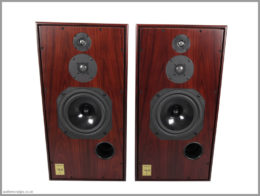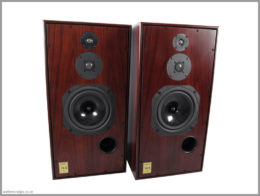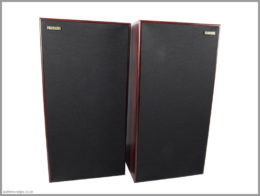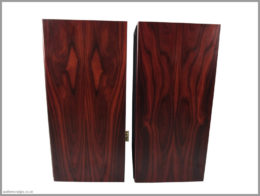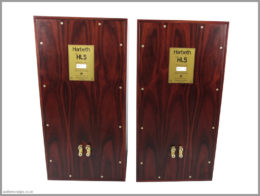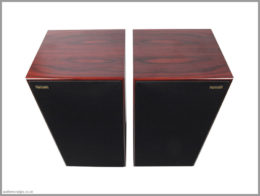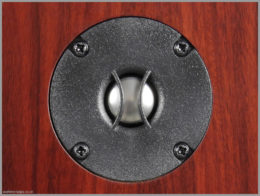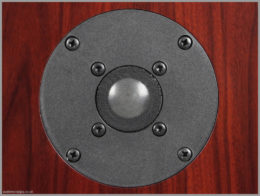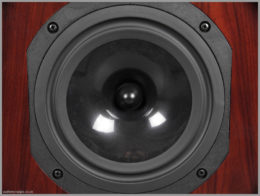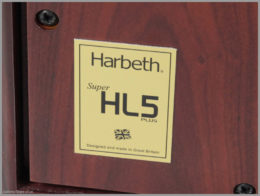TABLE OF CONTENTS
MY STORY WITH HARBETH SUPER HL5 PLUS
The open top wooden stands that I built for my Harbeth M30.1 have proven to be quite popular. Although I never planned building them to order, I was approached by a number of Harbeth owners asking if I would make a set for them. I have made a mutually beneficial agreement with a local Harbeth owner, where in exchange for being able to review his speakers, I would provide him with a reduced price for Audio Nostalgia speaker stands. This is how I ended up with a set of Harbeth Super HL5 Plus for a long weekend.
SPEAKER INFO
Model History
Harbeth Super HL5 Plus model is the latest iteration of the Harbeth HL-Monitor – the first loudspeaker model launched by Harbeth in 1977. In contrast to its previous generations, it now features a mid-bass driver with a diaphragm made of the most recent version of special blend injection moulded polypropylene, patented by Harbeth and referred to as RADIAL2. Apart from this, it also features a completely redesigned crossover.
Harbeth SHL5 Plus sits just below the Harbeth M40.1 in the Harbeth range. It features an in-house mid-bass 200mm unit that is also used in other models. Both tweeters are made by Seas, with the larger one featuring a 25mm aluminium diaphragm protected by a fine mesh and the smaller one featuring a 20mm titanium dome. The SHL5+, similarly to other Harbeth speakers are designed to sound best in domestic environments at normal listening levels (i.e. 70dB to 90dB). They are optimised for use away from walls and with tweeters at ear level.
Thin Wall Cabinet Design
Similar to other speakers in the Harbeth range, Harbeth SHL5 Plus are made from thin MDF walls veneered on both sides. It is a BBC originated design, where thin walls dampened with bitumen mats are responsible for moving the cabinet resonances down in the frequency range and for reducing their amplitude. Moreover, the screwed on front and real panels are responsible for reduction of resonances between the enclosure walls.
HARBETH SUPER HL5 PLUS SPECS
| Frequency Response: | 40 – 22,000Hz (+/- 3dB) |
| Sensitivity: | 86dB (1W input, measured at 1m) |
| Impedance: | 6Ω |
| Power Handling: | 150W |
| Super-High Frequency Driver: | 20mm Titanium Dome Tweeter |
| High Frequency Driver: | Seas 25mm Aluminum Dome Tweeter |
| Low Frequency Driver: | Harbeth 200mm RADIAL2™ Cone Woofer |
| Crossover Frequencies: | Unknown |
| Enclosure Type: | Bass Reflex |
| Enclosure Dimensions (HxWxD): | 638x322x300mm (25.1×12.7×11.8″) |
| Weight: | 17.2kg (each speaker) |
| Production Year: | 2015 – 2020 |
| Price When Launched: | £3,695 |
LOOK & FEEL OF HARBETH SHL5 PLUS
The veneer on each enclosure is matched and both enclosures are matched with each other. The cabinets are finished in a satin varnish, which means that you can feel and see the wood texture.
There are two sets of gold plated binding posts, that allow the speakers to be bi-wired or bi-amped. The binding posts are nothing fancy but they show a down to earth approach by the speaker designer.
The grills are an unusual design in comparison to other brands, with acoustically transparent cloth wrapped around a thin metal frame. The frame slides into narrow groves in the cabinet front and it is held there by friction. I like the idea behind it, because it prevents side reflections that you may find is more traditional thicker grilles, but it is far from ideal from a usability point of view. I found that removing these with neodymium magnets is by far the easiest and least invasive method.
All three drivers appear to be very well made, which is not really a surprise at this price point. The crossover features a large number of good quality components, although not the type that you may expect in speakers of this calibre – i.e. exotic film capacitors or large air-core inductors. This is not a criticism, merely an observation, which again shows a down to earth approach by Harbeth.
Overall, although the speaker finish is very nice with great attention to details, I have not fallen in love with the look of Harbeth Super HL5 Plus. This is of course very subjective and in my case mainly to do with the placement of the drivers on the front panel and square looking bass drivers.
According to Harbeth, the SHL5 Plus where designed, tuned and measured with the grilles on, which considering my opinion on their aesthetics is actually a good thing.
SOUND OF HARBETH SUPER HL5 PLUs
First Impressions
I had previously experienced the Harbeth Super HL5 Plus in my living room before obtaining the set for this review. This has given me a vague idea of what I could expect from them. Nonetheless, switching from something that you are familiar with (in my case the Harbeth M30.1) to something different is always an interesting experience. My initial impressions were that Harbeth SHL5 demonstrate a different tonal balance than the M30.1s. They appeared a little brighter and surprisingly less bass’y.
Bass
The bass of the SHL5s is very even handed. This is especially noticeable in my room on tracks like Darling Cory by Chris Jones, where the bass guitar can sound boomy on the M30.1s and perfectly fine on the SHL5s. The bass also goes significantly deeper and this can be experienced on well recorded drums, where the SHL5 sound more meaty. In keeping with all other Harbeth speakers with the 8in RADIAL2 driver, the dynamics and details in the upper bass are very impressive.
Midrange, Treble, and Soundstage
The midrange and treble are of very high quality which is not a surprise considering the pedigree and history of Harbeth. Vocals sound natural and open, but not as warm as on the M30.1s, which benefits some tracks such as Titanic by David Olney. If I was to compare them to another speaker in the Harbeth range, it would the P3ESR 40th Anniversary. This may please listeners with preferences for a more open and airy sound. However, my personal preference leans towards warmer voicing. Despite a more airy sound, the Harbeth Super HL5 Plus don’t seem to emphasise the ‘ts’ sibilance, but these are significantly more noticeable than on the Harbeth C7ES-3. String instruments sound great and realistic. They have more spark and air than guitars on the M30.1s but not as much body and warmth to them. This is easily noticeable on tracks like Where Shall I Be by Eric Bibb from the Spirit & The Blues album, where a guitar is played in isolation.
Similar to P3ESR 40th Anniversary and Monitor 30.1s, clapping sounds very real, which helps with creating the 3D sound stage illusion that Harbeth speakers are well known for. That can of course only happen if they are placed correctly in the listening room – i.e. away from walls. Both the width and the depth of the soundstage illusion are impressive. All of the above mentioned qualities make the Harbeth Super HL5 Plus really enjoyable to listen to.
If a lot of your music collection is comprised of well recorded and maybe not so well recorded albums, and you have a preference for a more open and airy sound, the Harbeth Super HL5 Plus could well be your perfect speaker.
CONCLUSION
Harbeth Super HL5 Plus are very well-balanced and open sounding speakers with quality midrange and impressive bottom end dynamics end extension. They are more airy and tonally leaner than most of the other speakers within Harbeth range. Despite this, they still preserve the forgiving quality that Harbeth is so well known for.
| Balance of Sound: | |
| Neutrality of Tone: | |
| Transparency: | |
| Soundstage: | |
| Attack: | |
| Engagement: | |
| Total Score: |
SONGS MENTIONED IN THIS REVIEW
Chris Jones – Darling Cory
David Olney – Titanic
Eric Bibb – Where Shall I Be
Reviewed: May 2019 | Published: November 2019


